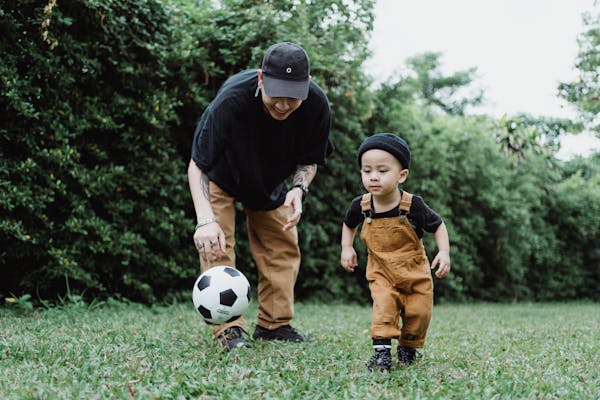Gentle Parenting: What It Is and How to Practice It

Gentle Parenting: What It Is and How to Practice It
Ever wondered how to raise a kind, confident kid without yelling or punishments? I used to stress about getting discipline “right” until I discovered gentle parenting. It’s not about being a pushover—it’s about guiding kids with empathy and respect. This 2025 guide breaks down what gentle parenting is and shares seven practical ways to practice it, weaving in respectful discipline, emotional coaching, and conscious parenting. Ready to build a stronger bond with your child? Let’s dive into gentle parenting!
Struggling with screen time? Check out our guide on managing screen time as a parent.
What Is Gentle Parenting, Anyway?
Gentle parenting is a nurturing approach that focuses on empathy, understanding, and connection over control. I tried it when my toddler threw a tantrum in the grocery store—instead of scolding, I knelt down, acknowledged her frustration, and offered a hug. It worked like magic! Research from the Cleveland Clinic shows gentle parenting fosters emotional intelligence and resilience in kids. It’s about conscious parenting—being intentional with your words and actions to raise a secure child.
Why Gentle Parenting Works
This approach builds trust and emotional security. Unlike traditional discipline, gentle parenting avoids fear-based tactics, focusing instead on respectful discipline that teaches kids self-regulation. A study by PositivePsychology.com found kids raised with empathy are more likely to develop strong problem-solving skills. My own kid started calming down faster when I modeled emotional coaching instead of time-outs. It’s not perfect, but it’s powerful.
1. Tune Into Your Child’s Emotions
Kids feel big emotions but lack the words to express them. I learned this when my son melted down over a broken toy. Instead of saying “It’s just a toy,” I said, “I see you’re upset—it’s hard when something breaks.” This emotional coaching validates their feelings and builds trust. Cleveland Clinic notes that naming emotions helps kids regulate them.
How to Start: Next time your child is upset, name their emotion: “You seem frustrated. Want to talk about it?”
2. Use Respectful Discipline Over Punishment
Punishments like time-outs can feel shaming. Respectful discipline guides kids to make better choices. When my daughter drew on the wall, I didn’t yell—instead, we cleaned it together while talking about why walls aren’t for drawing. Research from The Bump shows this approach teaches accountability without fear.
How to Start: Replace punishment with a teaching moment. Ask, “What can we do differently next time?”

3. Model the Behavior You Want
Kids are sponges—they mimic what you do. I started saying “I’m feeling overwhelmed, so I’m taking a deep breath” out loud, and soon my kid copied me during a tantrum. Conscious parenting means showing the calm and kindness you want them to learn. A PositivePsychology.com article highlights that modeling behavior shapes kids’ habits better than words alone.
How to Start: Show one positive behavior, like apologizing calmly, and watch your child follow.
4. Set Clear, Age-Appropriate Boundaries
Gentle parenting isn’t about no rules—it’s about fair ones. I set a “no toys at dinner” rule but explained why: “We talk and connect at the table.” Clear boundaries with reasons help kids feel secure. The Bump emphasizes consistent, kind limits for respectful discipline.
How to Start: Pick one boundary, explain it simply, and stick to it kindly.
5. Practice Active Listening
Listening is a game-changer in gentle parenting. When my son rambled about his day, I stopped scrolling my phone and really listened. He lit up! Active listening—eye contact, nodding, asking questions—shows kids they’re valued. Studies show this builds emotional intelligence (Cleveland Clinic).
How to Start: Put devices away and ask, “What was the best part of your day?”

Want to connect deeper with your kids? Learn tips for building a strong parent-child bond!
6. Encourage Problem-Solving
Instead of fixing your child’s issues, guide them to solutions. When my kids fought over a toy, I asked, “How can you share this fairly?” It took time, but they came up with a turn-taking plan. This emotional coaching fosters independence, as noted by PositivePsychology.com.
How to Start: Ask open-ended questions like, “What do you think we should do about this?”
7. Celebrate Efforts, Not Just Results
Praising effort over perfection builds confidence. I cheered when my daughter tried tying her shoes, even if the knot was messy. This aligns with conscious parenting, focusing on growth. Research shows effort-based praise boosts motivation (The Bump).
How to Start: Say, “I love how hard you tried!” instead of “Good job.”

Table: Gentle Parenting Strategies
| Strategy | Why It Works | How to Start |
|---|---|---|
| Tune Into Emotions | Builds trust and emotional intelligence | Name their feelings calmly |
| Respectful Discipline | Teaches accountability without fear | Replace punishment with teaching |
| Active Listening | Shows kids they’re valued | Ask about their day distraction-free |
| Encourage Problem-Solving | Fosters independence | Ask open-ended questions |
This table sums up key ways to practice gentle parenting!
Quote to Inspire Your Journey
“Parent with love, guide with kindness.” — Anonymous
This captures the heart of gentle parenting!
Common Mistakes to Avoid in Gentle Parenting
I’ve tripped up plenty starting out. Here’s what to watch for:
- Being Too Permissive: Gentle doesn’t mean no rules—set clear limits.
- Ignoring Your Own Needs: Self-care keeps you patient.
- Expecting Perfection: Progress, not perfection, is the goal.
Want to raise emotionally smart kids? Explore our guide on raising emotionally intelligent kids.
Why Gentle Parenting Is Worth It
Gentle parenting builds kids who feel safe, heard, and capable. It’s not always easy—trust me, I’ve had my share of messy moments—but the connection it fosters is priceless. Studies show kids raised with respectful discipline and emotional coaching are more empathetic and resilient (The Bump). It’s a long-term investment in your child’s heart and mind.
Conclusion: Start Your Gentle Parenting Journey
Embracing gentle parenting transforms your relationship with your child. With these seven steps—tuning into emotions, practicing respectful discipline, and modeling kindness—you’re set to raise confident, empathetic kids in 2025. Which tip will you try first? Share in the comments! For more parenting wisdom, check out our guide to raising emotionally intelligent kids. Here’s to parenting with love and connection!
Sources
- Cleveland Clinic. (n.d.). What is gentle parenting? Cleveland Clinic Health Essentials. https://health.clevelandclinic.org/what-is-gentle-parenting.
- PositivePsychology.com. (n.d.). Unleashing the power of gentle parenting (& 3 examples). PositivePsychology.com. https://positivepsychology.com/gentle-parenting/.
- The Bump. (n.d.). How to discipline your toddler. The Bump. https://www.thebump.com/a/toddler-discipline.








